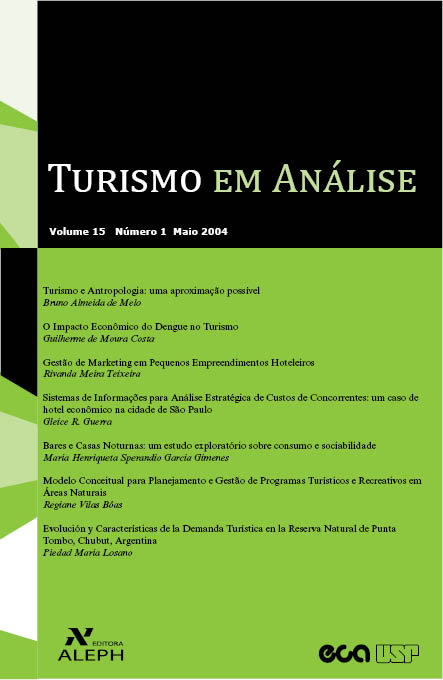Modelo conceitual para planejamento e gestão de programas turísticos e recreativos em áreas naturais
DOI:
https://doi.org/10.11606/issn.1984-4867.v15i1p89-102Palavras-chave:
planejamento turístico, planejamento participativo, programas turísticos e recreativos, áreas naturais, modelo conceitual.Resumo
Um modelo conceitual é desenvolvido nesse artigo com a finalidade de levar informações sobre planejamento turístico e recreativo e estimular decisões de grupos técnicos que trabalham com esse tema. Serão discutidos alguns componentes importantes do planejamento participativo de maneira a fornecer uma melhor visão da relação entre o ambiente natural, atividades de turismo/recreação, ecoturistas e comunidade local. Portanto, este artigo concentra a discussão de temas relacionados ao planejamento participativo de atividades turísticas e recreativas e ao manejo de áreas naturais, em que engenheiros florestais, turismólogos, planejadores, diretores e outros possam trabalhar em planos de gestão e conservação de forma a não interferir abruptamente no ambiente, tornar a experiência dos ecoturistas mais proveitosa, maximizar os benefícios econômicos e promover uma larga interação da comunidade local com os aspectos sociais e culturais.Downloads
Downloads
Publicado
Edição
Seção
Licença
Autores mantêm os direitos autorais e concedem à revista o direito de primeira publicação, com o trabalho simultaneamente licenciado sob a Creative Commons Attribution-NonCommercial-ShareAlike 4.0 International (CC BY-NC-SA 4.0), permitindo o compartilhamento do trabalho com reconhecimento da sua autoria e publicação inicial na RTA.
1. Autores mantêm os direitos autorais e concedem à revista o direito de primeira publicação, com o trabalho simultaneamente licenciado sob a Creative Commons Attribution-NonCommercial-ShareAlike 4.0 International que só permite uso não comercial e compartilhamento pela mesma licença, com sujeição do texto às normas de padronização adotada pela RTA.![]()
2. A Revista pode solicitar transferência de direitos autorais, permitindo uso do trabalho para fins não-comerciais, incluindo o direito de enviar o trabalho a bases de dados de acesso livre ou pagos, sem a obrigação de repasse dos valores cobrados dos usuários aos autores.
3. Autores têm autorização para assumir contratos adicionais separadamente, para distribuição não-exclusiva da versão do trabalho publicada nesta revista (ex.: publicar em repositório institucional ou como capítulo de livro), com reconhecimento de autoria e publicação inicial nesta revista.
4. A revista Turismo em Análise não cobra nada de seus autores para submissão ou publicação.











